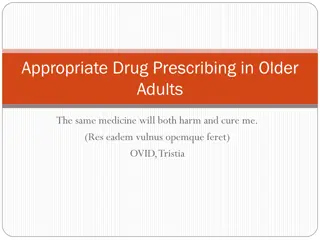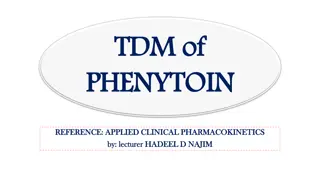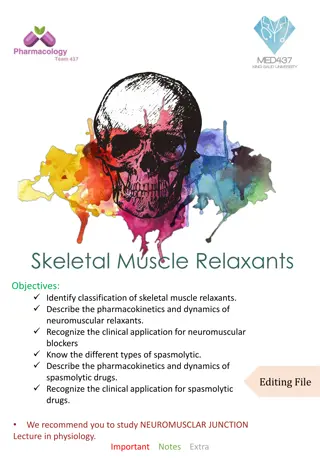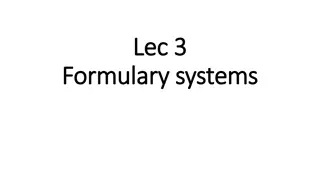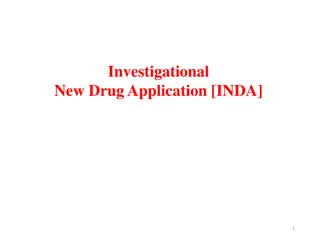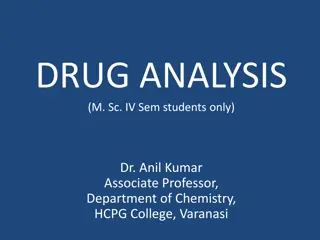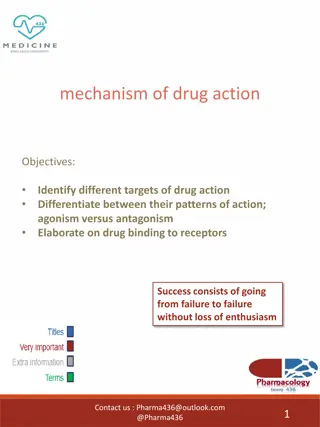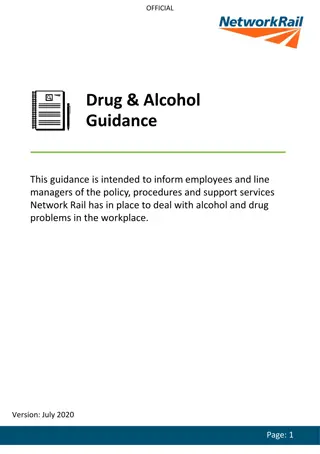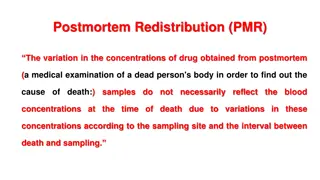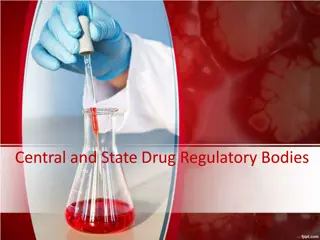Understanding Biopharmaceutics and Pharmacokinetics in Drug Development
Biopharmaceutics and pharmacokinetics play essential roles in the research, development, and optimization of pharmaceutical products. Biopharmaceutics focuses on the interrelationship of drug properties, dosage forms, and administration routes on drug absorption, while pharmacokinetics delves into drug absorption, distribution, and elimination in the body. By comprehending these concepts, pharmacists and pharmaceutical scientists can ensure the efficacy and safety of medications for patients.
Download Presentation

Please find below an Image/Link to download the presentation.
The content on the website is provided AS IS for your information and personal use only. It may not be sold, licensed, or shared on other websites without obtaining consent from the author. Download presentation by click this link. If you encounter any issues during the download, it is possible that the publisher has removed the file from their server.
E N D
Presentation Transcript
BIOPHARMACEUTICS All pharmaceuticals, from the generic analgesic tablet in the community pharmacy to the state-of-the-art immunotherapy in specialized hospitals, undergo extensive research and development prior to approval by the U.S. Food and Drug Administration (FDA). The physicochemical characteristics of the active pharmaceutical ingredient (API, or drug substance), the dosage form or the drug, and the route of administration are critical determinants of the in-vivo performance, safety and efficacy of the drug product. The properties of the drug and its dosage form are carefully engineered and tested to produce a stable drug product that upon administration provides the desired therapeutic response in the patient. Both the pharmacist and the pharmaceutical scientist must understand these complex relationships to comprehend the proper use and development of pharmaceuticals.
Biopharmaceuticsis the science that examines this interrelationship of the physicochemical properties of the drug, the dosage form in which the drug is given, and the route of administration on the rate and extent of systemic drug absorption. Thus, biopharmaceutics involves factors that influence (1) the stability of the drug within the drug product, (2) the release of the drug from the drug product, (3) the rate of dissolution/release of the drug at the absorption site, and (4) the systemic absorption of the drug. A general scheme describing this dynamic relationship is described in
The study of biopharmaceutics is based on fundamental scientific principles and experimental methodology. Studies in biopharmaceutics use both in-vitro and in-vivo methods. In-vitro methods are procedures employing test apparatus and equipment without involving laboratory animals or humans. In-vivo methods are more complex studies involving human subjects or laboratory animals. PHARMACOKINETICS After a drug is released from its dosage form, the drug is absorbed into the surrounding tissue, the body, or both. The distribution through and elimination of the drug in the body varies for each patient but can be characterized using mathematical models and statistics. Pharmacokinetics is the science of the kinetics of drug absorption, distribution, and elimination (ie, excretion and metabolism). The description of drug distribution and elimination is often termed drug disposition
The study of pharmacokinetics involves both experimental and theoretical approaches. The experimental aspect of pharmacokinetics involves the development of biologic sampling techniques, analytical methods for the measurement of drugs and metabolites, and procedures that facilitate data collection and manipulation. The theoretical aspect of pharmacokinetics involves the development of pharmacokinetic models that predict drug disposition after drug administration. The application of statistics is an integral part of pharmacokinetic studies. CLINICAL PHARMACOKINETICS During the drug development process, large numbers of patients are tested to determine optimum dosing regimens, which are then recommended by the manufacturer to produce the desired pharmacologic response in the majority of the anticipated patient population. However, intra- and interindividual variations will frequently result in either a subtherapeutic (drug concentration below the MEC) or toxic response (drug concentrations above the minimum toxic concentration, MTC), which may then require adjustment to the dosing regimen. Clinical pharmacokinetics is the application of pharmacokinetic methods to drug therapy. Clinical pharmacokinetics involves a multidisciplinary approach to individually optimized dosing strategies based on the patient's disease state and patient-specific considerations.
PHARMACODYNAMICS Pharmacodynamics refers to the relationship between the drug concentration at the site of action (receptor) and pharmacologic response, including biochemical and physiologic effects that influence the interaction of drug with the receptor. The interaction of a drug molecule with a receptor causes the initiation of a sequence of molecular events resulting in a pharmacologic or toxic response. Pharmacokinetic-pharmacodynamic models are constructed to relate plasma drug level to drug concentration in the site of action and establish the intensity and time course of the drug. Pharmacodynamics and pharmacokinetic-pharmacodynamic models are discussed more fully in. TOXICOKINETICS AND CLINICAL TOXICOLOGY Toxicokinetics is the application of pharmacokinetic principles to the design, conduct, and interpretation of drug safety evaluation studies and in validating dose-related exposure in animals. Toxicokinetic data aids in the interpretation of toxicologic findings in animals and extrapolation of the resulting data to humans. Toxicokinetic studies are performed in animals during preclinical drug development and may continue after the drug has been tested in clinical trials. Clinical toxicology is the study of adverse effects of drugs and toxic substances (poisons) in the body.
MEASUREMENT OF DRUG CONCENTRATIONS Because drug concentrations are an important element in determining individual or population pharmacokinetics, drug concentrations are measured in biologic samples, such as milk, saliva, plasma, and urine. Sensitive, accurate, and precise analytical methods are available for the direct measurement of drugs in biologic matrices. Such measurements are generally validated so that accurate information is generated for pharmacokinetic and clinical monitoring. In general, chromatographic methods are most frequently employed for drug concentration measurement, because chromatography separates the drug from other related materials that may cause assay interference.
Sampling of Biologic Specimens Only a few biologic specimens may be obtained safely from the patient to gain information as to the drug concentration in the body. Invasive methods include sampling blood, spinal fluid, synovial fluid, tissue biopsy, or any biologic material that requires parenteral or surgical intervention in the patient. In contrast, noninvasive methods include sampling of urine, saliva, feces, expired air, or any biologic material that can be obtained without parenteral or surgical intervention. The measurement of drug and metabolite concentration in each of these biologic materials yields important information, such as the amount of drug retained in, or transported into, that region of the tissue or fluid, the likely pharmacologic or toxicologic outcome of drug dosing, and drug metabolite formation or transport.
Plasma Level Time Curve The plasma level time curve is generated by obtaining the drug concentration in plasma samples taken at various time intervals after a drug product is administered. The concentration of drug in each plasma sample is plotted on rectangular-coordinate graph paper against the corresponding time at which the plasma sample was removed. As the drug reaches the general (systemic) circulation, plasma drug concentrations will rise up to a maximum. Usually, absorption of a drug is more rapid than elimination. As the drug is being absorbed into the systemic circulation, the drug is distributed to all the tissues in the body and is also simultaneously being eliminated. Elimination of a drug can proceed by excretion, biotransformation, or a combination of both.
The relationship of the drug level time curve and various pharmacologic parameters for the drug is shown in . MEC and MTC represent the minimum effective concentration and minimum toxic concentration of drug, respectively. For some drugs, such as those acting on the autonomic nervous system, it is useful to know the concentration of drug that will just barely produce a pharmacologic effect (ie, MEC). Assuming the drug concentration in the plasma is in equilibrium with the tissues, the MEC reflects the minimum concentration of drug needed at the receptors to produce the desired pharmacologic effect. Similarly, the MTC represents the drug concentration needed to just barely produce a toxic effect. The onset time corresponds to the time required for the drug to reach the MEC. The intensity of the pharmacologic effect is proportional to the number of drug receptors occupied, which is reflected in the observation that higher plasma drug concentrations produce a greater pharmacologic response, up to a maximum. The duration of drug action is the difference between the onset time and the time for the drug to decline back to the MEC.
In contrast, the pharmacokineticist can also describe the plasma level time curve in terms of such pharmacokinetic terms as peak plasma level, time for peak plasma level , and area under the curve , or AUC. The time of peak plasma level is the time of maximum drug concentration in the plasma and is a rough marker of average rate of drug absorption. The peak plasma level or maximum drug concentration is related to the dose, the rate constant for absorption, and the elimination constant of the drug. The AUC is related to the amount of drug absorbed systemically.
Drug Concentrations in Tissues Tissue biopsies are occasionally removed for diagnostic purposes, such as the verification of a malignancy. Usually, only a small sample of tissue is removed, making drug concentration measurement difficult. Drug concentrations in tissue biopsies may not reflect drug concentration in other tissues nor the drug concentration in all parts of the tissue from which the biopsy material was removed. For example, if the tissue biopsy was for the diagnosis of a tumor within the tissue, the blood flow to the tumor cells may not be the same as the blood flow to other cells in this tissue. In fact, for many tissues, blood flow to one part of the tissues need not be the same as the blood flow to another part of the same tissue. The measurement of the drug concentration in tissue biopsy material may be used to ascertain if the drug reached the tissues and reached the proper concentration within the tissue.
Drug Concentrations in Urine and Feces Measurement of drug in urine is an indirect method to ascertain the bioavailability of a drug. The rate and extent of drug excreted in the urine reflects the rate and extent of systemic drug absorption. The use of urinary drug excretion measurements to establish various pharmacokinetic parameters is discussed in. Measurement of drug in feces may reflect drug that has not been absorbed after an oral dose or may reflect drug that has been expelled by biliary secretion after systemic absorption. Fecal drug excretion is often performed in mass balance studies, in which the investigator attempts to account for the entire dose given to the patient. For a mass balance study, both urine and feces are collected and their drug content measured. For certain solid oral dosage forms that do not dissolve in the gastrointestinal tract but slowly leach out drug, fecal collection is performed to recover the dosage form. The undissolved dosage form is then assayed for residual drug.
Drug Concentrations in Saliva Saliva drug concentrations have been reviewed for many drugs for therapeutic drug monitoring . Because only free drug diffuses into the saliva, saliva drug levels tend to approximate free drug rather than total plasma drug concentration. The saliva/plasma drug concentration ratio is less than 1 for many drugs. The saliva/plasma drug concentration ratio is mostly influenced by the pKa of the drug and the pH of the saliva. Weak acid drugs and weak base drugs with pKa significantly different than pH 7.4 (plasma pH) generally have better correlation to plasma drug levels. The saliva drug concentrations taken after equilibrium with the plasma drug concentration generally provide more stable indication of drug levels in the body. The use of salivary drug concentrations as a therapeutic indicator should be used with caution and preferably as a secondary indicator. Significance of Measuring Plasma Drug Concentrations The intensity of the pharmacologic or toxic effect of a drug is often related to the concentration of the drug at the receptor site, usually located in the tissue cells. Because most of the tissue cells are richly perfused with tissue fluids or plasma, measuring the plasma drug level is a responsive method of monitoring the course of therapy.
Clinically, individual variations in the pharmacokinetics of drugs are quite common. 1-Monitoring the concentration of drugs in the blood or plasma ascertains that the calculated dose actually delivers the plasma level required for therapeutic effect. With some drugs, receptor expression and/or sensitivity in individuals varies, so monitoring of plasma levels is needed to distinguish the patient who is receiving too much of a drug from the patient who is supersensitive to the drug. 2-Moreover, the patient's physiologic functions may be affected by disease, nutrition, environment, concurrent drug therapy, and other factors. Pharmacokinetic models allow more accurate interpretation of the relationship between plasma drug levels and pharmacologic response. In the absence of pharmacokinetic information, plasma drug levels are relatively useless for dosage. 3-Monitoring of plasma drug concentrations allows for the adjustment of the drug dosage in order to individualize and optimize therapeutic drug regimens. In the presence of alteration in physiologic functions due to disease, monitoring plasma drug concentrations may provide a guide to the progress of the disease state and enable the investigator to modify the drug dosage accordingly. Clinically, sound medical judgment and observation are most important. Therapeutic decisions should not be based solely on plasma drug concentrations.
In many cases, the pharmacodynamic response to the drug may be more important to measure than just the plasma drug concentration. For example, the electrophysiology of the heart, including an electrocardiogram (ECG), is important to assess in patients medicated with cardiotonic drugs such as digoxin. For an anticoagulant drug, such as dicumarol, prothrombin clotting time may indicate whether proper dosage was achieved. Most diabetic patients taking insulin will monitor their own blood or urine glucose levels For drugs that act irreversibly at the receptor site, plasma drug concentrations may not accurately predict pharmacodynamic response. Drugs used in cancer chemotherapy often interfere with nucleic acid or protein biosynthesis to destroy tumor cells. For these drugs, the plasma drug concentration does not relate directly to the pharmacodynamic response. In this case, other pathophysiologic parameters and side effects are monitored in the patient to prevent adverse toxicity.







